Ngrams and the Changing Vocabulary of Class Analysis in 19th Century Classical Liberal Thought
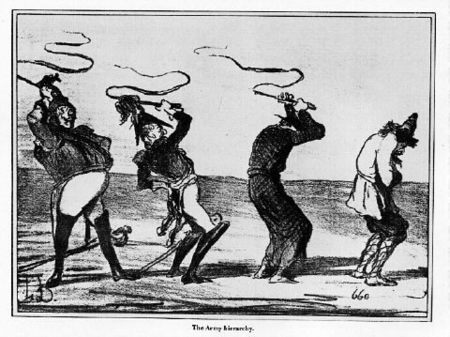 |
|
Honoré Daumier, "The Army Hierarchy" (1850s)
[See higher resolution image] |
What are Ngrams?
According to the Wikipedia article on The Google Ngram Viewer:
The Google Ngram Viewer or Google Books Ngram Viewer is an online search engine that charts frequencies of any set of comma-delimited search strings using a yearly count of n-grams found in sources printed between 1500 and 2008 in Google's text corpora in American English, British English, French, German, Spanish, Russian, Hebrew, or Chinese, generated in either 2008 or 2012; there are also some specialized English-language corpora, such as English Fiction. ...
The program can search for a single word or a phrase, including misspellings or gibberish. The n-grams are matched with the text within the selected corpus, optionally using case-sensitive spelling (which compares the exact use of uppercase letters), and, if found in 40 or more books, are then plotted on a graph.
Ngrams and the word "Liberal"
To my knowledge, Daniel Klein was the first libertarian to use Ngrams in an essay he wrote in 2015 on the changing meaning of the word "liberal".[1] This was part of a campaign he organised to "reclaim" the word liberal from American leftists who who have been using it to describe the "New Liberalism" of the Progressive Period in which it meant the opposite of what it had traditionally meant.
We inlude two of his Ngrams here to illustrate what he was doing:
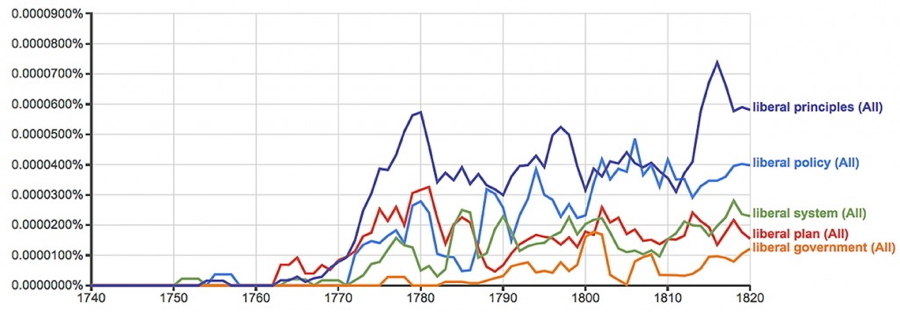 g g
|
 g g
|
Ngarms and the Vocabulary of Class
In a recent Liberty Matters online discussion of “Classical Liberalism and the Problem of Class” (Nov. 2016)[2] we (Steve Davies and David Hart) used Ngrams to explore the use of key expressions or terms by classical liberals and radical individualists during the 19th cnetury to describe their ideas about exploitation and the rule of some powerful individuals over others. In other words, to explore the evolving idea of class anlaysis within classical liberal social theory.
Some of the terms we examined included the following:
English language terms:
- industrious classes
- idle classes
- ruling elite
- ruling class
- sinister interest
- ruling few
- Ceux qui pillent
- stipendiary class
- paper aristocracy
- Boroughmonger
- squire-archy
- landed oligarchy
- oligarchical interest
- industrious order
- the militant type of society
- the industrial type of society
- plutocracy
French language terms:
- la classe dirigeante
- oligarchie gouvernante
- industrialisme
- industrieux
- classe industrieuse
- classe électorale
- la spoliation
- spoliation légale
- les spoliés
- classe spoliatrice
- classe budgétivore
What follows is a compilation of that discussion. [Note: CLCA = Classical Liberal Class Analysis.]
Steve Davies begins by noting that, very often the ideas of CLCA were not spelt out or elaborated at length but simply alluded to, normally through the use of. There are constant references for example to “the industrious classes” in the central part of the century with a marked peak in the 1840s, as the Google Ngram shows.
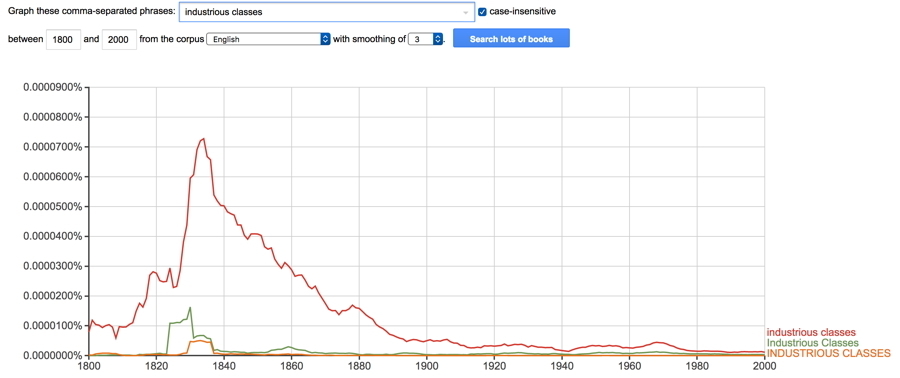
|
The Ngram for the corresponding term “the idle classes” is even more striking, with a series of peaks that correspond to upsurges in popular radical liberalism.
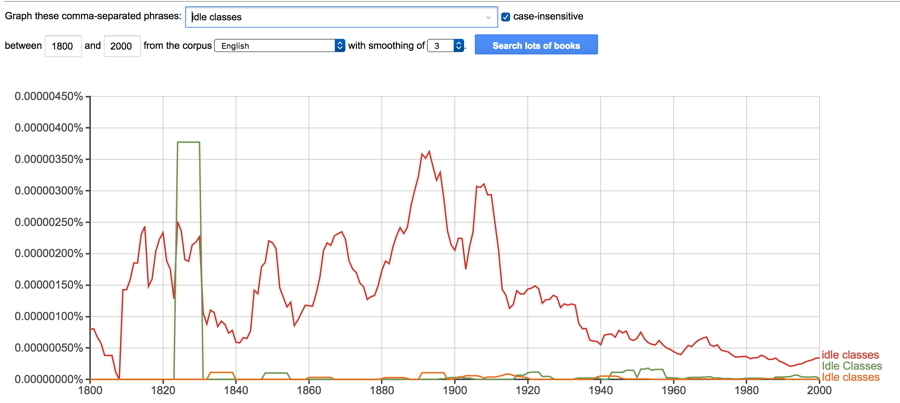
|
The crucial point here is that the people who used the vocabulary of CLCA and embedded its arguments and analysis into their writings did so without elaborating it. What this shows is that the ideas were so widespread and generally known that they could be alluded to with confidence that the reader would understand the argument simply from the reference. In other words, CLCA was a pervasive and widely understood idea that was an important part of both political culture and language and popular culture more generally.
“The Changing Vocabulary of Class Part 1: English Classical Liberals and Radicals”
David Hart continued the discussion begun by Steve Davies with two posts of "the changing vocabulary of class" used by English and French classical liberals. He noted that, my hunch is that one reason for the success of Marxist notions of class since the appearance of The Communist Manifesto in 1848 was how quickly Marxists and their supporters were able to settle on a set of key terms to describe their theory, terms such as the capitalist class, the working class, the proletariat, the bourgeoisie, and so forth. Classical liberals on the other hand were not able to settle on a similar set of limited terms to describe their ideas about rule and exploitation by a politically privileged elite. When they did use terms to describe their ideas they were very time specific, thus making the ideas behind them seem appear idiosyncratic and perhaps even quaint as the century wore on.
By the end of the 19th century the generic notion of “the ruling class” had become commonly used, most probably as part of a socialist view of class domination (whether Marxist or Laborite), as the graph below indicates (the time period is between 1750 to 1900 for all the graphs I generated).
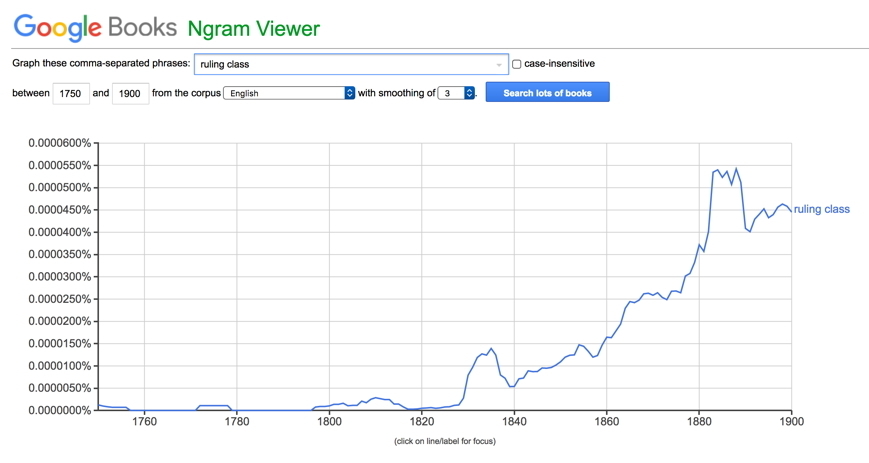
|
The following are some examples selected from my larger list of CLCA theorists, in this post focusing on English Classical Liberal and Radical word usage.
The Philosophic Radicals around Jeremy Bentham and James Mill developed their own unique vocabulary dealing with class with such terms as “the sinister interest” and “the ruling few”. Use of these terms reached a peak in the late 1830s after the success of the campaign for electoral reform with the passage of the First Reform Act in 1832 which ushered in a series of liberal reforms including the repeal of the Corn Laws in 1846. After that, the use of the Benthamite vocabulary of class practically disappeared - along with, I would argue, their notion of class.
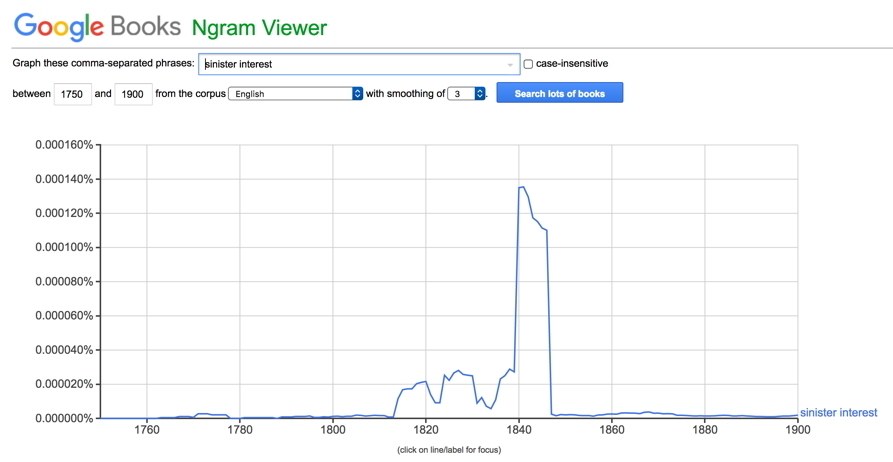
|
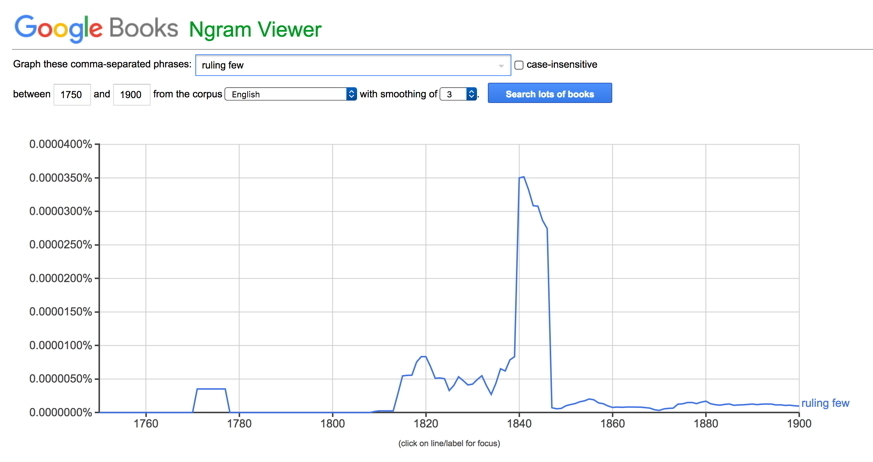
|
Other terms which were common among late 18th and early 19th century radicals were the physiocrat Turgot’s idea of “the stipendiary class” (also used by English speaking authors), those who lived from incomes (stipends) from government service or payments on government loans (peaked in the 1790s); and William Cobbett’s term “paper aristocracy” also used to describe those who lived off the returns of government loans (peaked in 1820 and again in the 1830s), and “boroughmongers” who were able to control elections to the House of Commons by using the seats which were attached to their extensive land-holdings (peaked in 1820 and again during the agitation for the Reform Act of 1832).
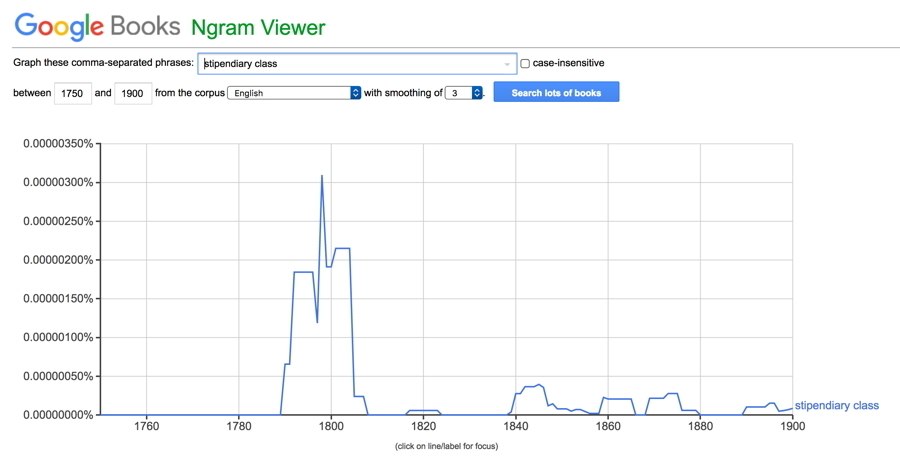
|
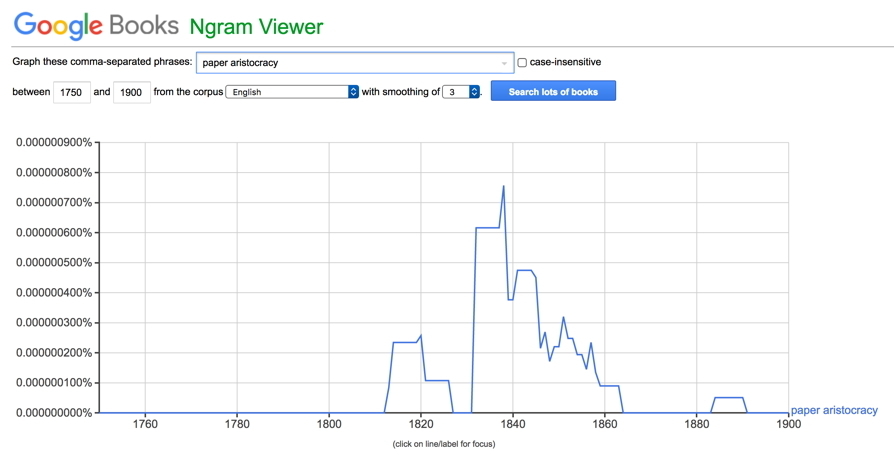
|
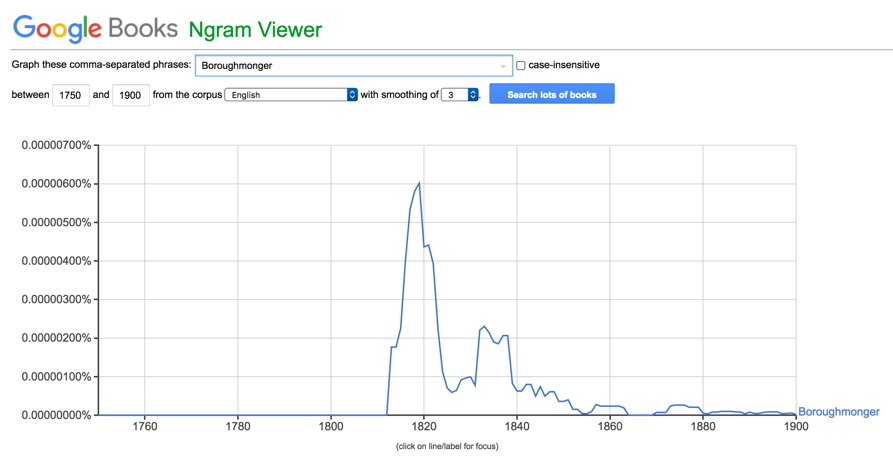
|
Two exceptions to this tendency for certain terms to peak at the time of some specific piece of legislative reform and then die out afterwards seems to be John Wade’s (a Radical) use of the term “oligarchical interest” with which he used to describe English elites between the 1820s and 1840s, which also had a use periodically throughout the rest of the 19th century when his form of Radicalism had largely disappeared. The same goes for Richard Cobden’s use of the term “squirearchy” to describe the large landowners who benefitted from agricultural protectionism and their control of elections to the unreformed House of Commons. Thus reached a peak during the campaign against the Corn Laws in the 1840s but continued to be quite widely used throughout the rest of the century. It is likely that these terms appealed to other radicals and socialists who used them frequently later in the century.
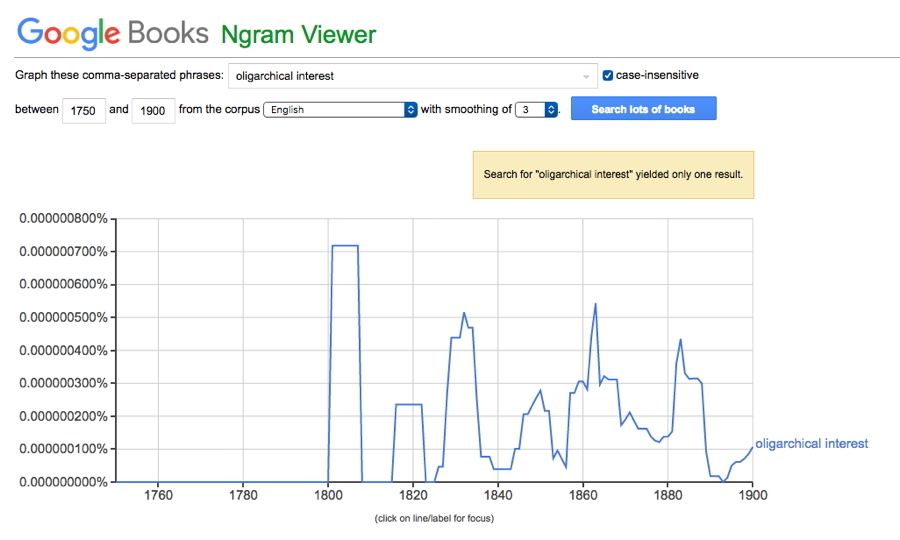
|
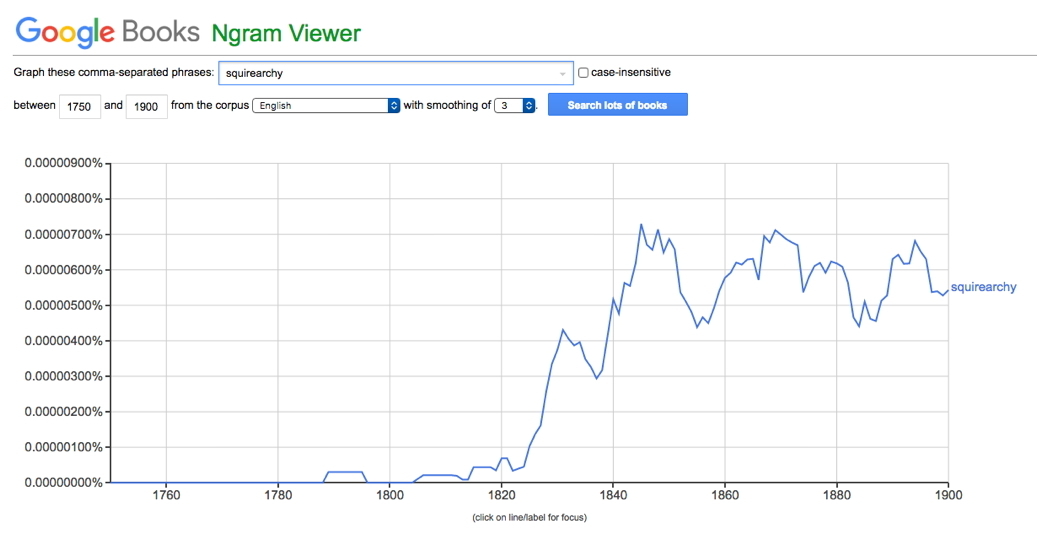
|
Later in the century, beginning in the 1870s and continuing for another 20 years, Herbert Spencer began to write his monumental works on political sociology in which he developed ideas like “the militant type” and the “industrial type” of society. The use of the term “militant type of society” peaked in the early 1880s and again around 1890. The graph for the term "industrial type of society" matches this almost exactly, suggesting the two were used as a pair.
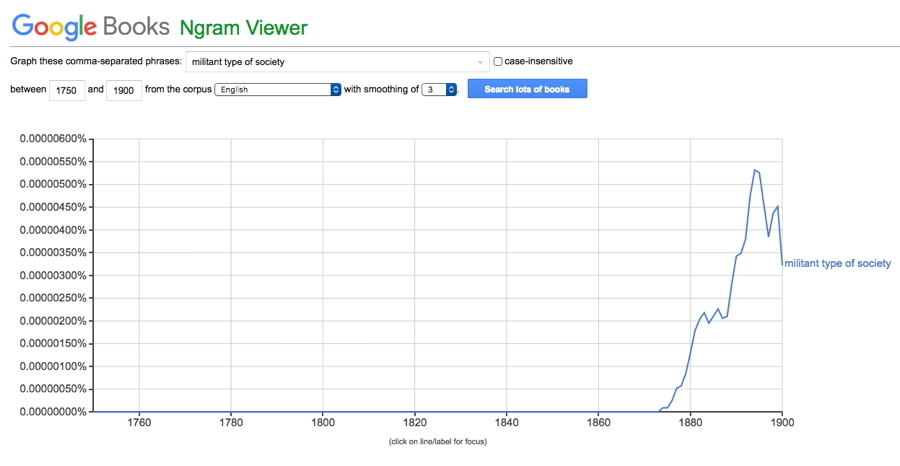
|
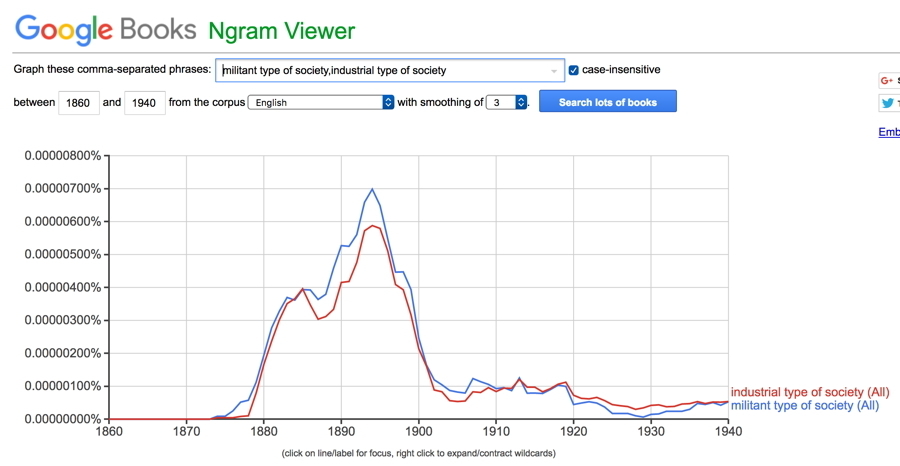
|
Two other rather generic terms which became popular in the late 19th century are “plutocracy” which was used by the American sociologist William Graham Sumner (peaking in the 1890s) and “ruling elite” which was taken up by Vifredo Pareto in the late 1890s (his notion of “the circulation of elites”). This is another example of a term used by both Classical Liberals and as well as by others and which quickly lost any specifically liberal connotation it might have had.

|
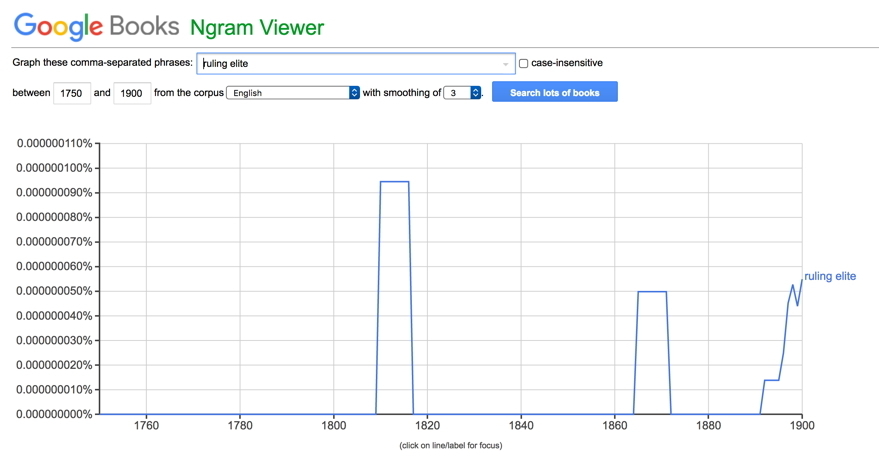
|
I believe that CLCA was hampered by the lack of a commonly accepted vocabulary with which to discuss class rule by privileged elites. This reflects the gradual loss of interest CLs had in this idea as the century wore on as well as the fact that class analysis was never fully integrated into modern CL thought as it seemed to be on the verge of doing earlier in the century.
“The Changing Vocabulary of Class Part 2: French Classical Liberals and the Political Economists” (29 Nov. 2016)
Here I want to examine some French language terms to describe class analogous to what I did earlier for English language terms.
Likewise, by the end of the 19th century the generic notion of “la classe dirigeante" (the ruling class) had become commonly used, most probably as part of a socialist view of class domination, as the graph below indicates (the time period is between 1750 to 1900 for all the graphs I generated). There is a suddeen spike in the late 1870s which I attribute to the rise of socialist parties in the new Third Republic. There is a similar pattern for the general term "l'oligarchie gouvernante" (the ruling oligarchy).
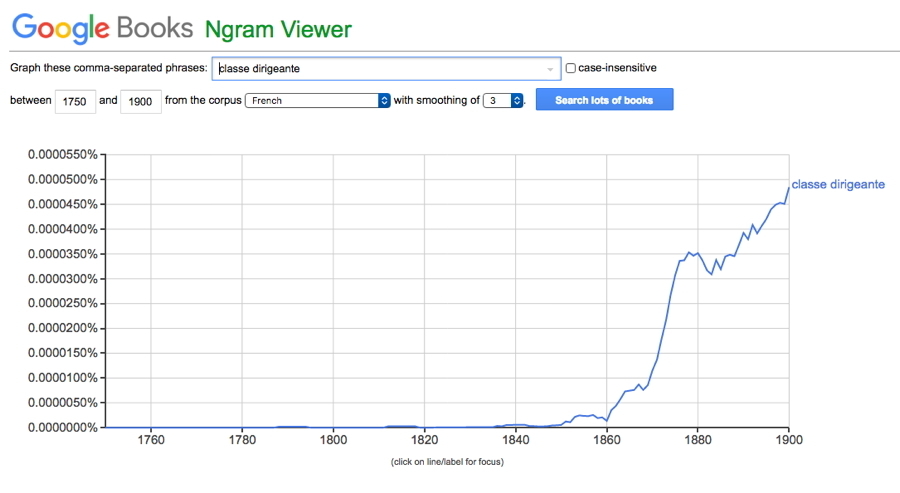
|
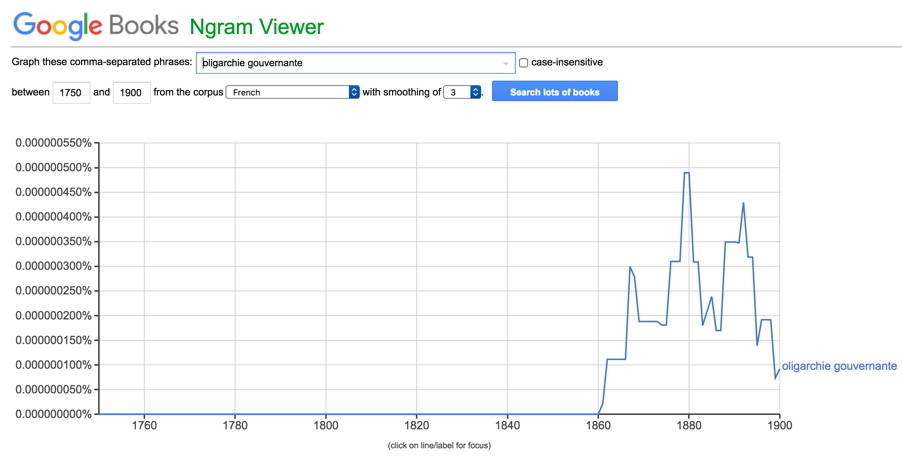
|
During the 1810s and 1820s, under the influence of the economic ideas of the 18th century Physiocrats and in the Restoration period the work of Jean-Baptiste Say and Benjamin Constant, Charles Comte and Charles Dunoyder developed a theory of "industrialisme" (industrialism) by which they meant a system where the productive class, known as "les industrieux" or "la classe industrieuse" (the industrious or productive class), had the freedom to produce and trade with others with minimal or no regaultion and taxation by the state and other "unproductive classes". After the 1848 Revolution the term "industrialism" lost its liberal Dunoyer-inspired meaning and became a general term to describe the industrial economy as we know it today.
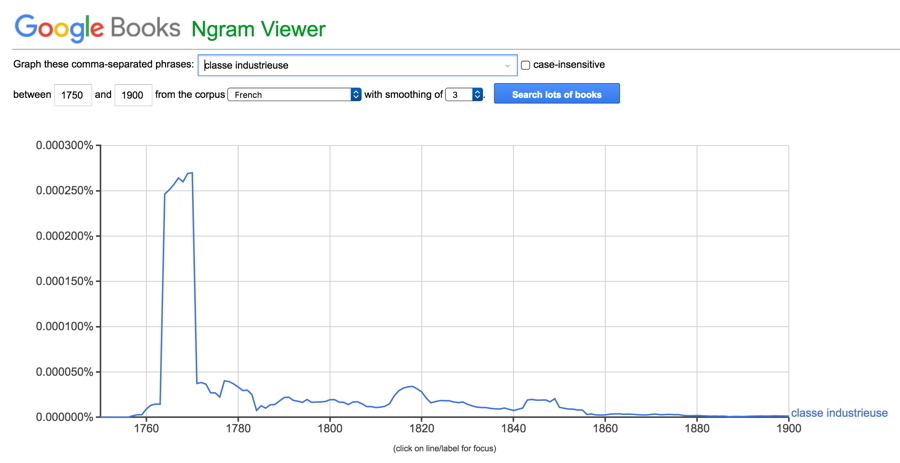
|

|

|
Frédéric Bastiat adopted the phrase "la classe électorale" (the electoral class) to dscribe the very limited number of wealthy people who were allowed to vote during the July Monarchy (1830-1848) and who were able to use this political dominance to impose tariffs to protect French agriculture and manufacuring. The use of the term reached a peak around the time of the Revolution of 1848 which introduced universal manhood suffrage. It reached another peak at the time of the discussion of the structure of the Third Republic in the early 1870s.
)
|
Another key term in Bastiat's theory of class is the idea of "la spoliation" (plunder). Those who benefited from tariffs and subsidies were called "la classe spoliatrice" (the plundering class) and those who were plundered he called "les spoliés" (the plundered). The use of the term "la classe spoliatrice" (the plundering class) reached a peak in the late 1840s just before Bastiat died, and another smaller peak when the second edition his Collected Works were pubished in the 1860s. Related to this was his theory of "la spoliation légale" (legal plunder) which he used to describe the institutionalisation of plunder by the state.
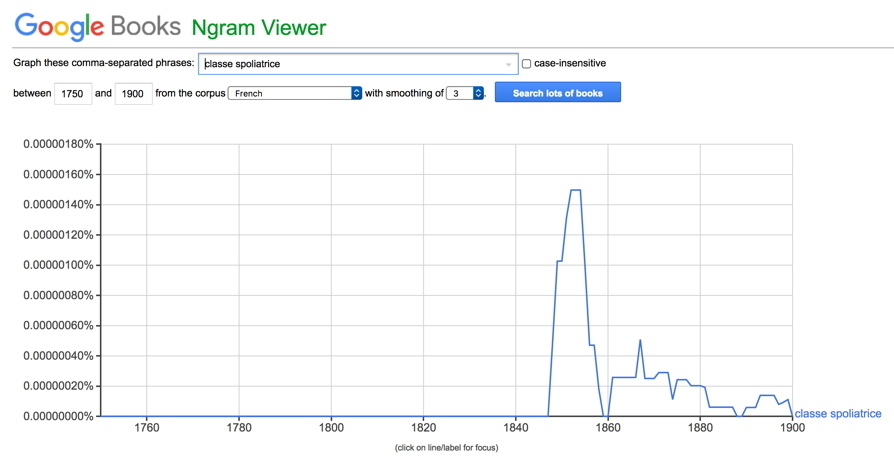
|
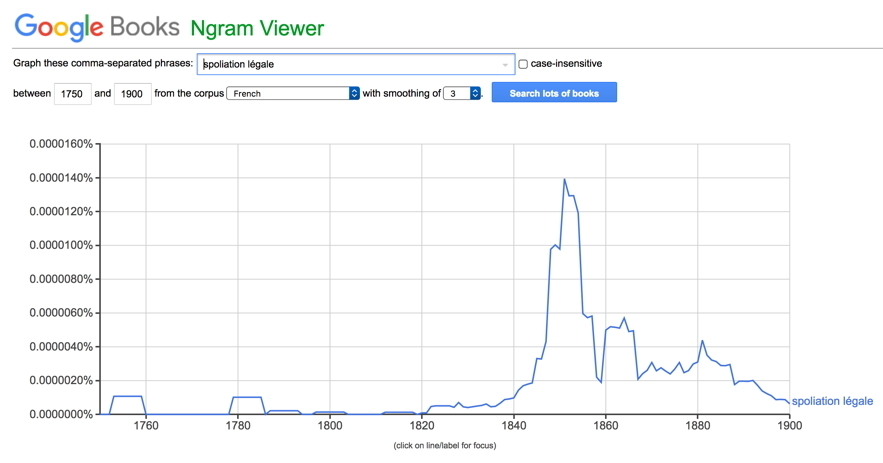
|
Bastiat's younger friend and colleague Gustave de Molinari used the charming term “la classe budgétivore" (the budget eating class) to describe how vested instersts and government employees "ate" tax payers' money and thus formed a disctinct class in oppostiion to taxpayers. He began using the term in the 1850s and continued to use after he became editor of the Journal des Économistes in 1881. I can't explain the spike in its use around 1840.
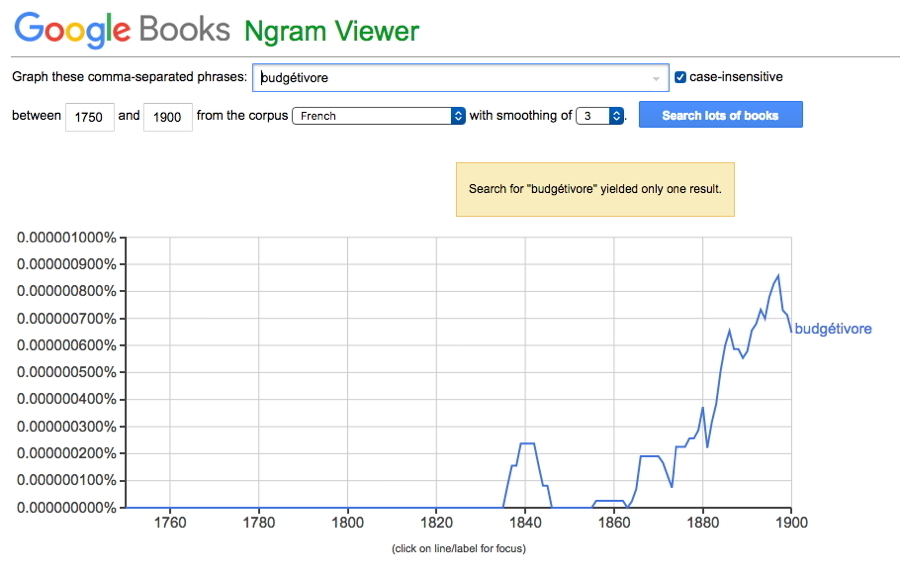
|
Once again, we see the diversity of terms used by French classical liberals and political economists to describe class and class exploitation with no commonly used terminology being adopted. I believe this hampered the development of this "second tradition" of liberal thinking about class and left the field clear for a socialist or Marxist vocabulary and way of thinking about class to become the dominant one.
Conclusion
Steve Davies concludes his discussion with the observation that, David Hart’s enterprising use of the Ngram shows, as he says, just how many terms were used by the early classical liberals to label the thing they were talking about. I agree that this very diversity of terminology hampered the adoption of the theory in academia as that arena became professionalized in the later 19th and early 20th century. However, I think his findings reveal something further and more profound, which is that there was not one CLCA but several, with very different ideas about the nature and origin of the “ruling class” and consequently different analyses and proposals.
The version of CLCA that is the most radical and which I would regard as the core notion is the one articulated by the French theorists using the language of plunder or rule. In its simplest or crudest form this means that in a given society, there are some who gain wealth via the institutionalized use of physical force or fraud. The more profound idea developed from this is the objective analysis of government that George Smith describes. In this the existence of institutionalized force itself creates a class or category of people who depend upon it and use it and who are objectively dependent upon that kind of social relation, regardless of what their personal motives and beliefs are. In the other implicit theories the institutionalized force is already there and is then used by or attractive to social formations that may already exist for other reasons. In this way of thinking, it is that kind of social relation (a relation of predation rather than production, we might say) that actually creates the social class and the division between it and the rest of society.
The first point I would make is that this plethora of names reveals the way that several quite distinct perspectives coexisted and were often conflated. However the radical French one (also shared by Spencer, as George points out) was the one that had the greatest purchase intellectually, partly because of its multidisciplinary origins. Unfortunately the term “ruling class,” which best captures what its argument was, was appropriated early on by the Marxists, and once a term of label is claimed in this way it becomes difficult (though not impossible) for other groups to use it.
The second point is that these various perspectives are not exclusive. We can keep them distinct while using them all, since they identify distinct phenomena. The radical French theory is in some sense the foundational, or master, theory, particularly when combined with a historical/anthropological account of how power-based relations arise in the first place. The other theories are then accounts of important secondary phenomena such as the way that the existence of a power center and of a class of people associated with and created by it gives rise to other social pathologies. This would also fit in with the typology or classification David sets out, in which there is a core social category of a distinct ruling class and then other classes defined to a great extent by their relation to that first class.
[Read the complete online discussion here.]
Endnotes
[1.] See, Daniel B. Klein, “The Origin of ‘Liberalism,’” The Atlantic, February 13, 2014 <https://www.theatlantic.com/politics/archive/2014/02/the-origin-of-liberalism/283780/> and Daniel B. Klein, “A Plea Regarding “Liberal”,” Modern Age, Summer 2015. <https://home.isi.org/plea-regarding-liberal-0>. He and Ryan Daza have a website devoted to this topic, "Lost Language, Lost Liberalism" <http://www.lostlanguage.org/generations/>.
[2.] David M. Hart, “Classical Liberalism and the Problem of Class” (Nov. 2016) </pages/lm-class>. Previous discussion can be found here </pages/liberty-matters>.